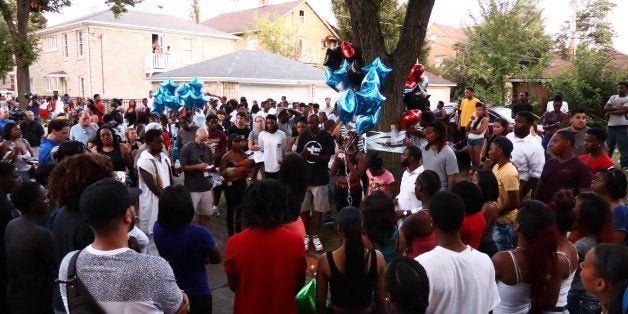
It is Saturday morning and I have spent all weekend packing up my belongings from my parents northside Milwaukee home into my first apartment. Nina Simone's "Baltimore" is on repeat. My best friend and now roommate is on the opposite side of town doing the same; it will be her first time living on the northside. I have constantly reassured her that despite what we see on television, Milwaukee is more than its problems.
Fast forward to Saturday night and we've settled in. We enjoy a glass of champagne, toasting the first of many nights in our new home. I check my phone as I often do and see a friend and local community organizer sharing lengthy messages of anger and frustration. The gas station I normally go to Sunday mornings after church is on fire. Another black man has been killed at the hands of police and Milwaukee is experiencing pain unlike I have ever seen. I am not surprised at the death. I am shocked at the aftermath. In all my years in this city, the people of Milwaukee have never responded so blatantly.
It was a scene out of an all too real and all too good '90s Spike Lee movie. The smoke was strong, but the smell was stronger. The city was, in fact, burning. I could almost feel the heat on my skin. While I was not in midst of the protesting, I saw friends, exchanged concerned expressions with community members and did the only thing I knew best: reported the narrative the way I saw it, in person and on social media.
Sudan Smith, brother of 23-year-old victim Sylville Smith, was hysterical. I only caught him for a moment when I said "I am here for you" to which he responded "I have nothing left."
Sudan Smith, brother of 23-year-old victim Sylville Smith, was hysterical. I only caught him for a moment when I said "I am here for you" to which he responded "I have nothing left." Many were there to express genuine anger; others were there to capture images for their social media. There was constant yelling. City bus shelters were pushed into the middle of the street and overturned, bricks and other objects were thrown in every direction, gunshots were fired, six businesses were burned and police cars were damaged.
It is Sunday morning and community and faith leaders and members began a community clean-up picking debris. Others meander and converse trying to make sense of Saturday night's anguish. It is 4 in the afternoon and a man named Craig of the neighborhood has attracted a large audience in front of a group shooting dice. He delivers an impassioned speech how blacks have gone from being identified as slaves to indentured servants to willing laborers as though history is somehow trying to diminish our struggle or our work ethic. Fast forward a few hours and a march has begun. A candlelight vigil was held. Brothers and sisters of different ethnicities, religion, etc. have gathered to pray in hopes to heal the community.
What was a peaceful setting soon is loud and claustrophobic. For a moment, all you hear are police sirens. We see the discharge of officers in riot gear from the city buses. We have been told the National Guard is activated and ready to support the police department if things get out of hand. It is 11 p.m. and we hear back-to-back popping sounds. I have never heard the sound of a gun so close. Bricks are being thrown at police and gun shots can be heard in the surrounding area. A police officer and an individual that was shot are both hospitalized. Several arrests have been made, and the anger is heavy. The presence of officers in heavy riot gear causes an untrustworthy atmosphere. It is shortly after 1 a.m. and a car is burning blocks away. The city is tired, yet resilient.
It is difficult to be a black journalist on days like this. We are taught our grief comes second to our stories to produce unbiased work. I have spent many days on frontlines and on the streets of the movement at the expense of falsified narratives by media personnel who don't stick around long enough to hear the entire story. Being media is forcing me to see my city and my people in a new lens. While I had an emotional connection to Trayvon Martin, Mike Brown, Alton Sterling, men who could have easily been my father, nothing felt as out-of-body as Sylville Smith. The proximity is still unsettling.
While I had an emotional connection to Trayvon Martin, Mike Brown, Alton Sterling ... nothing felt as out-of-body as Sylville Smith. The proximity is still unsettling.
It is also difficult to be from Milwaukee most days. Our police chief Ed Flynn gave a four-step action plan for "not getting shot in Milwaukee" in May, before retracting his statements early summer. Our sheriff David Clarke Jr. believes the Black Lives Matter movement is a "hateful ideology." Our governor Scott Walker has a history of proposing legislation impacting public sector employees.
Milwaukee is the most segregated city in the United States. Problems not only exist in racial relations, but housing segregation, employment, incarceration and education. The disparity in high school graduation rates between white and black students in Wisconsin is the highest in this country. Wisconsin suspends black students at a higher rate than any other state, all while noting that Milwaukee and Wisconsin lead the nation in black imprisonment.
The major issue is community relations between citizens and police. Several predominately black areas are over-policed and under-worked. Everyone has a comment to make about the neighborhoods they're trying so hard to avoid. These neighborhoods need investment towards some kind of growth and progress; neighborhoods like 53206, America's most incarcerated zip code.
I don't know what the next step is, but I understand oftentimes events need to occur and anger needs to be manifested to address the pressing issues. Milwaukee has this safe communal space every year known as the Heal the Hood Block Party. We approach concerning topics with peace, unity and resilience. Dancing and food are always involved. We recognize and come to peace with the violence in order to build. And with pieces of our city burning, we are in desperate need of picking up the debris and rebuilding.
It is now early Monday morning and Nina's "Baltimore" echoes in my mind. My city is asleep after two days of unrest and I am trying to find the words to eloquently explain these last 48 hours. I realize there is nothing eloquent about unrest, just waves of weariness. My Spotify playlist shuffles through nothing but sad morning love songs. I replace the names and pronouns of each sad song with Milwaukee. There is no time for inner-city blues. Soon the city will awake again and we will work to heal the hood.
